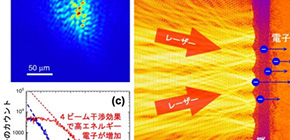
Balancing Beams: Multiple Laser Beamlets Show Better Electron and Ion Acceleration
Researchers at Osaka University demonstrated that using multiple high-energy laser beamlets to accelerate electron and ion beams improved the energy transfer efficiency
A research team led by Osaka University showed how multiple overlapping laser beams are better at accelerating electrons to incredibly fast speeds, as compared with a single laser. This method can lead to more powerful and efficient X-ray and ion generation for laboratory astrophysics, cancer therapy research, as well as a path toward controlled nuclear fusion.
High-energy-density physics is a field of study that deals with conditions much closer the chaotic moments immediately following the Big Bang than those commonly encountered on Earth. However, being able to produce and control intense beams of light, or very fast-moving electrons, has many practical benefits. These include the ability to make very bright X-rays needed for visualizing ultrafast deformation of matter, or conducting experiments that mimic the cosmological conditions near the surface of a star.
However, it is often tricky to keep efficiently accelerating electron beams with intense laser beams because of complex interactions between the laser and electrons. Previously, very expensive optics or patterned targets were required to transfer laser energy to the electron beam energy. In a new study, researchers at Osaka University showed how splitting the laser beam into four coherent smaller beams, called beamlets, allows more energy to be transferred to electrons. This was accomplished by creating specific light interference patterns that keep the electrons on track.
“Just like overlapping ripples in pond can create complex wave structures, we can use four laser beamlets to precisely control the environment to best accelerate the electrons,” explains first author Dr. Morace. They found that the simultaneous irradiation of multiple laser beams at a single point allows for highly efficient laser-driven particle acceleration. Using light interference patterns instead of physical targets allows for better control and increased energy transfer.
The team sees this as just the beginning of the new technique. “This research shows how new, high-performance lasers systems utilizing multi-beam coupling can be developed,” says senior author Dr. Kodama. “This means that the method may soon appear in biology departments or fusion power plants.”

Figure 1
The work is published in Nature Communications as “Enhancing laser beam performance by interfering intense laser beamlets.” (DOI: https://doi.org/10.1038/s41467-019-10997-1 )
Related links

